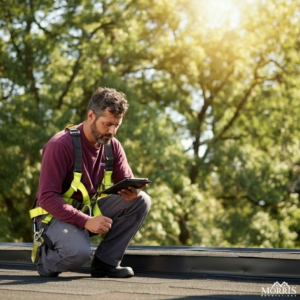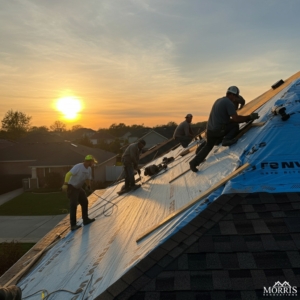DIY Roof Inspection: Tips and Tricks
DIY Roof Inspection: Tips and Tricks

DIY Roof Inspection: Tips and Tricks
Roof inspections are a crucial part of home maintenance. They help ensure the longevity of your roof and the safety of your home.
However, hiring a professional for a roof inspection can be costly. This is where DIY roof inspections come into play.
Conducting your own roof inspection can save you money. It also allows you to understand the condition of your roof better.
In this guide, we will provide you with practical tips and tricks for a DIY roof inspection. We’ll cover everything from safety precautions to identifying potential issues.
Remember, regular roof maintenance can prevent costly repairs in the future. It’s an investment in the longevity of your home.
So, let’s dive into the world of DIY roof inspections and learn how to keep your roof in top shape.
Understanding the Importance of Roof Inspections
Regular roof inspections are essential for maintaining a safe and durable home. They help identify potential issues before they become major problems.
A well-maintained roof not only protects your home but also increases property value. It can even lower insurance premiums by reducing risks of damage.
It’s recommended to inspect your roof at least twice a year. Doing so can catch signs of wear and tear early, preventing costly repairs.
Consider these key benefits of regular roof inspections:
- Extend the lifespan of your roof.
- Prevent water damage and leaks.
- Maintain energy efficiency and insulation.
- Protect structural integrity of your home.
Ignoring roof maintenance can lead to severe consequences. Delayed repairs may result in more extensive damage, increasing expenses and stress.
Proactive roof inspections provide peace of mind. They ensure that your home remains a safe and comfortable environment for your family.
When to Conduct a DIY Roof Inspection
Knowing when to inspect your roof can save you from unexpected repairs. Ideally, roof inspections should occur at least twice yearly. Consider aligning them with seasonal changes, like in spring and fall.
Inspect your roof after severe weather events, such as storms or heavy snowfall. Harsh weather can cause damage that worsens over time if left unchecked. Addressing issues early is crucial in preventing further deterioration.
Here are key times to conduct a DIY roof inspection:
- Transition between seasons, especially after winter and summer.
- After severe weather conditions, like hailstorms or high winds.
- When there are signs of roof aging, like worn shingles or water stains.
Trust your instincts—if something seems off, check it promptly. Scheduling regular roof assessments helps you stay ahead of potential problems. Staying vigilant will preserve both your roof and peace of mind.
Safety First: Preparing for Your Roof Inspection
Safety is paramount when preparing for a DIY roof inspection. Before you begin, make sure you have a stable ladder and check it thoroughly for defects. An unstable ladder is a major hazard, and ensuring it is firm and secure can prevent accidents.
Dress appropriately to ensure maximum safety. Wear shoes with good grip to avoid slipping and gloves to protect your hands. The right gear can make a difference in maintaining your safety while on the roof.
Here are some essential safety precautions to follow:
- Inspect your ladder for damage before each use.
- Wear non-slip shoes and protective gloves.
- Avoid inspecting your roof in wet, windy, or icy conditions.
Choose a day with clear weather to perform your inspection. Slippery surfaces are dangerous and can lead to falls or other accidents. Take your time and exercise caution as you navigate your roof. Prioritizing safety ensures you can inspect your roof without unnecessary risks.
Essential Tools for a DIY Roof Inspection
To conduct a DIY roof inspection efficiently, having the right tools at hand is crucial. The right equipment not only aids in a thorough inspection but also enhances safety. Gather these before climbing onto your roof to ensure you’re well-prepared.
Consider creating a checklist of essential tools. This can help you avoid multiple trips up and down your ladder. Here’s what you should have ready:
- Stable, high-quality ladder
- Durable work gloves
- Flashlight for dark areas
- Binoculars for inspecting distant sections
- Roof shoes with good traction
A flashlight comes in handy for checking dark areas, like attics. Binoculars allow you to examine distant parts of the roof from the ground. Always prioritize safety and efficiency when selecting your tools for roof inspection. With the right tools, you can perform a more effective and detailed roof inspection.
Step-by-Step Guide to Inspecting Your Roof
Embarking on a roof inspection can be daunting, but breaking it into steps makes it manageable. Start with a systematic approach to cover all essential areas of your roof. Use a checklist to ensure nothing is overlooked.
Inspecting the Shingles
Begin your inspection with the shingles. Look for visible signs of damage such as cracks, curling, or missing shingles. Damaged shingles need immediate attention to prevent further deterioration.
Take note if you find granules missing from the shingles, as this is a sign of aging. Shingles are your roof’s first defense against the elements, so ensuring they are in good shape is essential.
Checking Flashing and Sealing
Next, inspect the flashing and seals. These are common areas where leaks can develop. Look for gaps, rust, or cracks that might compromise the roof’s waterproofing.
Ensure all seals around roof fixtures like chimneys and skylights are intact. Proper sealing prevents water from seeping into your home, protecting the interior from damage.
Gutters and Downspouts
Move on to the gutters and downspouts. These should be free from obstructions like leaves or twigs. Blocked gutters can lead to water overflow, affecting the roof and walls.
Check for any signs of sagging or damage. Well-maintained gutters ensure efficient water drainage, preventing potential roof damage during heavy rain.
Attic and Ventilation Check
Finish with an attic and ventilation check. Proper ventilation is key to a healthy roofing system. Look for signs of moisture or mold, which indicate poor ventilation or leaks.
Ensure there is no blocked airflow and assess for any daylight peeking through, as this could signal a hole in the roof. A well-ventilated attic helps extend the lifespan of your roof by minimizing heat and moisture buildup.
Identifying Common Roof Problems
Recognizing common roof problems early can save you from costly repairs later. Each type of damage has different indicators. Understanding these signs will help you assess the roof’s condition effectively.
Here are some typical roof issues to watch for:
- Leaks and Water Stains: Water spots on the ceiling or walls can suggest a leak.
- Sagging Roof Areas: Indicates structural issues; should be addressed immediately.
- Moss or Algae Growth: Can damage shingles and retain moisture, leading to leaks.
- Cracked or Peeling Shingles: Show aging or weather damage, needing prompt replacement.
- Poor Insulation: Results in fluctuating indoor temperatures and increased energy costs.
Additionally, check for loose or exposed nails, which may indicate wear or need tightening. Pay attention to any unusual noises from the roof, especially after storms, as these can signify emerging issues. By identifying these problems during inspections, you’ll keep your roof in top shape longer.
When to Call a Professional: Limitations of DIY Roof Inspections
While DIY roof inspections can help save money, they are not a complete substitute for professional evaluations. There are certain situations where it’s best to call in the experts. Issues like significant structural damage, persistent leaks, or complex roof systems require a professional’s touch.
Moreover, if you feel unsafe during any part of the inspection, it’s crucial to seek professional assistance. Professional roofers have specialized tools and experience to safely navigate and assess your roof. Remember, safety is more important than saving costs. Hiring a certified roofer can ensure a thorough and accurate assessment.
Maintaining Your Roof: Post-Inspection Tips and Tricks
After completing your roof inspection, it’s time to focus on maintenance tasks. Regular maintenance prolongs the lifespan of your roof and minimizes future repair costs. A well-kept roof also keeps your home safe and energy-efficient.
Start by addressing any minor repairs identified during your inspection. Fixing small issues can prevent them from escalating into expensive problems. Ensure gutters and downspouts are clear to maintain effective drainage.
Consider creating a maintenance routine to keep your roof in top shape year-round. Here are some useful tips to incorporate into your routine:
- Trim overhanging branches to prevent debris build-up.
- Check for and remove any moss or algae growth regularly.
- Seal any exposed nails or gaps to avoid water infiltration.
- Clean gutters and downspouts at least twice a year.
Regularly observing your roof’s condition helps detect issues before they worsen. Keeping your roof in good condition protects your home and your investment.
Conclusion: The Value of Regular Roof Maintenance
Regular roof maintenance is crucial for preserving your home’s structural integrity. Consistent care reduces the risk of significant repairs and prolongs the life of your roof. A well-maintained roof also enhances your home’s curb appeal and overall value.
Investing time in inspections and preventive measures offers long-term benefits. It keeps your home protected from harsh weather conditions and potential water damage. By understanding and implementing effective roof maintenance practices, you ensure a safe and sound environment for your family.









